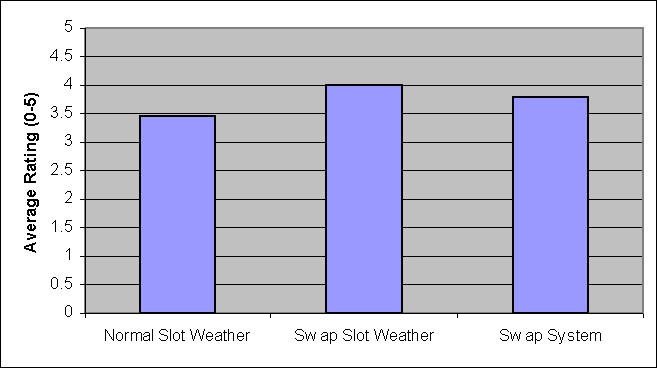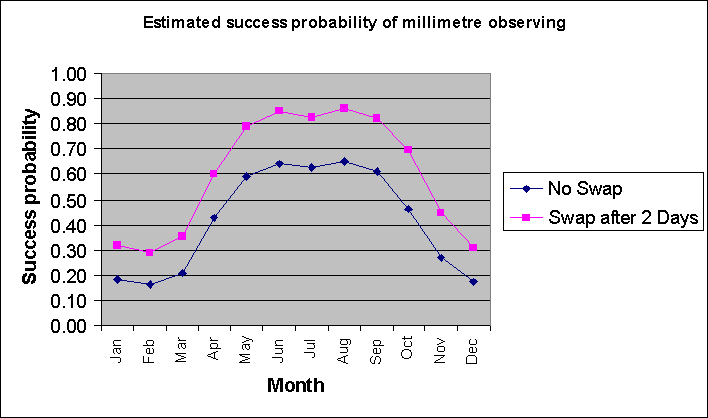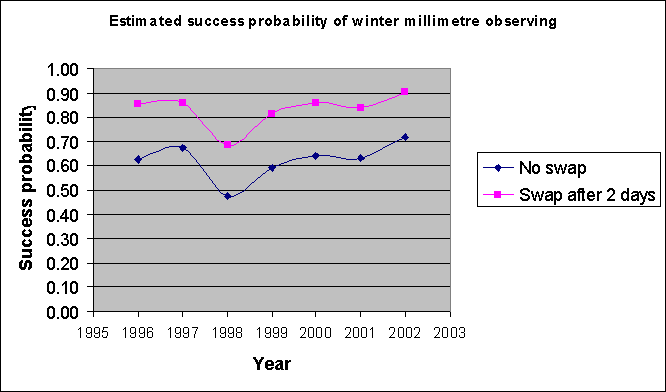
The following table gives the number of swap pairs, the number of swaps that were initiated and the observing hours at 3mm, 12mm and centimetre wavelengths during the May and September terms. Some 3mm projects did not have swap partners. In May term, this was dominated by a single proposal which required 7 slots coincident with satellite observations (it did not make scientific sense to make this swappable). In September, the 3mm slots without swaps were partially from people requesting 3mm observations when no swapping had been advertised. The last 3mm run during September term was on 21 October.

3mm projects accounted for about 17% and 5% of observing in the May and September terms respectively. 22% of possible swaps were initiated. In May term, only about 2 hours of 3mm observing was completely useless because of weather. In September term, the weather was somewhat more difficult (particularly in October) and the data quality did degrade (e.g. there was some 3mm observing on quite hot days near the end of October). However only about 5 hours were completely useless - and this was a result of wind stows (i.e. centimetre observing would also have been equally impossible). In terms of weather, then, the swap scheme has been quite successful this winter.
The graph below gives the averages of the swap/scheduling related questions from the millimetre user questionnaire (responses are ratings from 0 to 5). These are consistent with the number of swaps initiated. Note the perception of the swap system is that of the millimetre astronomers (not their centimetre swap partner). Average ratings from ATCA questionnaires are usually around 4.4, so the responses to these are somewhat low.

A disadvantage of the swap scheme has been that the centimetre observers have had little say in whether their project is a suitable candidate for swapping. The centimetre observer has to be prepared for a swap, and for the possibility that they need not go to the observatory. This introduces some uncertainty into their planning. There is potential for a complicated centimetre project to be picked as a swap partner. Indeed this did happen. One of the swapped-in centimetre programs did suffer some mild degradation because of a poor choice of calibrators. Although the centimetre observer was alerted to this during the early stage of the observation, they were not in a position to resolve the problem.
An additional shortcoming was that, in a modest number of cases, the 3mm observer's commitment to the swap program (or indeed swapping) was not there. A number of 3mm observers decided to forgo their swap (sometimes weeks in advance) for their own convenience. It could be argued that this is their prerogative to risk poor weather. I do not agree: the aim of the scheduling mode is to ensure maximum effective use of the array, regardless of the weather.
Below are two plots giving estimates of the probability of a successful 3mm observing run. These use 7 years of weather data (October 1995 to September 2002), and use a simple model to determine (in hindsight) the probability of getting a good 9-hour slot. See Appendix A for more detail. This criterion gives reasonable guidance for the weather in the winter just past: whereas in practice 22% of swaps were initiated this winter, this model suggests we would have expected 28%.
In the plots below, two curves are given: the first giving the raw probability that there is a good 9-hour slot. The second curve is aimed at determining how better the odds are if we can ``swap'' a millimetre run with a later slot (i.e. the probability of suitable weather either in the original slot or the swap slot). Swap delays of 1, 2, 3 and 4 days was evaluated: swaps 2, 3 or 4 days later were not significantly different, whereas they were about 4-5% more successful than a 1-day swap delay. A swap delay of 2 days is given below. Two days is attractive in that it is not an unreasonable extra length of time for an observer to stay at the observatory, and because weather forecasts two days ahead should provide good guidance on the suitability of the swap slot weather.
The model suggests there is a 60-65% chance of weather suitable for 3mm observing during the ``winter'' months of May through September. By combining this with the option to swap with a slot 2 days later, the probability improves to 80-85%. This year (2002 winter) has been a good one, but it is only about 5% better than a median year. 1998 (the year of significant winter flooding) was a poor year. The analysis with month agrees with previous analysis (and the impressions during 2002): good conditions start in May, and the weather starts falling apart in October, and the height of summer is unsuitable.

